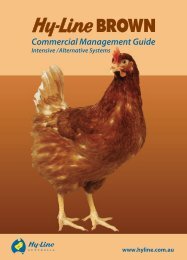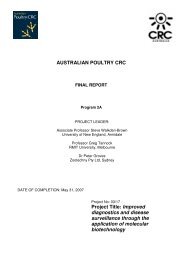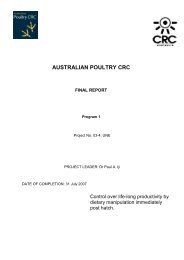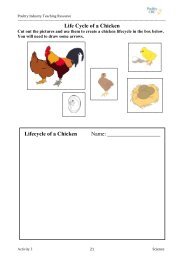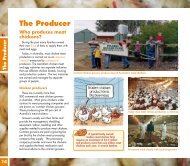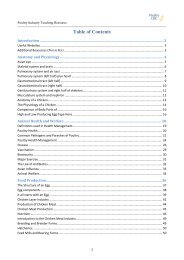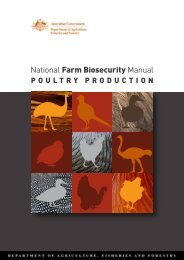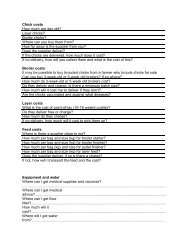AUSTRALIAN POULTRY CRC - Poultry Hub
AUSTRALIAN POULTRY CRC - Poultry Hub
AUSTRALIAN POULTRY CRC - Poultry Hub
- No tags were found...
Create successful ePaper yourself
Turn your PDF publications into a flip-book with our unique Google optimized e-Paper software.
clinically infected and recovered birds shed oocysts in their droppings, which contaminate feed, dust,water, litter and soil, with fresh oocysts not infective until they sporulate (Kahn, 2005).WormsWorms of poultry live in the digestive tract and spread from bird to bird via eggs passed out in thedroppings. A worm infestation may be indicated by poor growth or decreased egg production, loss ofappetite, emaciation, weakness, ruffled appearance, drooping wings, diarrhoea, anaemia and inextreme cases, death. Common types of worms found in poultry are:Roundworms (Ascaridia galli) – Roundworms are white worms approximately 5 - 12 cm longthat occur in the small intestine (McMullin, 2004). Eggs are passed out in the droppingswhere they are picked up by other birds and hatch in the intestine. In suitable conditions, theeggs remain infective in the soil for up to four months.Caecal worms (Heterakis gallinarum) – These small (07 – 1.5cm long) worms are found in thelumen of the caeca of poultry. They have a direct life cycle with earthworms and housefliesacting as mechanical transport hosts (McMullin, 2004). These worms must be present in largenumbers before a detrimental effect on the bird is noticed however they can harbour theorganism which causes the protozoan disease “blackhead”.Hair worms (Capillaria spp.) – Hair worms are long thread-like worms found in the crop,oesophagus, small intestine and caecum. Eggs are passed out in droppings and must beingested by an intermediate host (i.e. earthworm), with the life cycle completed when the birdeats the earthworm and the parasite are released into the gut (Permin and Hansen, 1998).Infections with hair worms can be highly pathogenic for birds kept in deep-litter or free rangesystems where big numbers of infective eggs may build up in the litter or soil (Permin andHansen, 1998).Tapeworms – <strong>Poultry</strong> reared under free range conditions can become infected withtapeworms. All tapeworms of poultry have indirect life cycles with intermediate hosts (i.e.earthworms, beetles and flies) essential to perpetuate the life cycle (Permin and Hansen,1998). They range in size from 5 – 15 cm in length and are segmented and ribbon-like. Eggsform in the segments which break off when they are ripe and are passed out in droppings.Endoparasites - mitesThree types of mites are of economic importance to the poultry industry, the tropical fowl mite, redmite and scaly leg mite. The tropical fowl mite (Ornithonyssus bursa) is found in tropical and subtropicalareas where wild birds carry the parasite from farm to farm. These mites can be found on theskin of the birds throughout the day whereas the red mite (Dermanyssus gallinae) is only found on thehost during the night. During the day it retreats into cracks and crevices in the poultry shed andequipment. Infected birds may have a change in behaviour due to the itching effect of the mites.Weight loss, decreased egg production, anaemia and death are clinical signs with mites also being ableto transmit a number of diseases (i.e. fowl pox and Newcastle disease) (Permin and Hansen, 1998).The scaly leg mite (Cnemidocoptes mutans) is found under the scales of the legs of birds with birdsbeing infected from the ground. These mites tunnel into the skin and cause the scales to lump up andform crusts (McMullin, 2004). This causes keratinisation of the legs and in chronic cases lamenessand malformation of the feet are seen.PredatorsBirds kept in free-range systems are at risk of predation from foxes, wild cats, dogs, snakes, eagles andhawks. The establishment of a proper fence and closing pop-holes at night may prevent attacks fromfoxes, wild cats, and dogs; however, predation from eagles and hawks is harder to control.4



